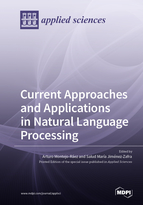Current Approaches and Applications in Natural Language Processing
A special issue of Applied Sciences (ISSN 2076-3417). This special issue belongs to the section "Computing and Artificial Intelligence".
Deadline for manuscript submissions: closed (31 January 2022) | Viewed by 91837
Special Issue Editors
Interests: natural language processing; machine learning; deep NLP; text mining; knowledge engineering; linked data
Interests: natural language processing; negation detection and treatment; semantics; text mining
Special Issues, Collections and Topics in MDPI journals
Special Issue Information
Dear Colleagues,
Current approaches in Natural Language Processing (NLP) have shown impressive improvements in many major tasks: machine translation, language modelling, text generation, sentiment/emotion analysis, natural language understanding, question answering, among others. The advent of new methods and techniques like graph-based approaches, reinforcement learning or deep learning have boosted many of the tasks in NLP to reach human-level (and even further) performance. This has attracted the interest of many companies, so new products and solutions can profit from the advances of this relevant area within the artificial intelligence domain.
This Special Issue focuses on emerging techniques and trendy applications of NLP methods is an opportunity to report on all these achievements, establishing a useful reference for industry and researchers on cutting edge human language technologies. Given the focus of the journal, we expect to receive works that propose new NLP algorithms and applications of current and novel NLP tasks. Also, updated overviews on the given topics will be considered, identifying trends, potential future research areas and new commercial products.
The topics of this Special Issue include but are not limited to:
- Question answering: open-domain Q&A, knowledge-based Q&A...
- Knowledge extraction: Relation extraction, fine-grained entity recognition...
- Text generation: summarization, style transfer, dial...
- Text classification: Sentiment/emotion analysis, semi-supervised and zero-shot learning...
- Behaviour modelling: early risk detection, cyberbullying, customer modelling...
- Dialogue systems: chatbots, voice assistants...
- Reinforcement learning
- Data augmentation
- Graph based approaches
- Adversarial approaches
- Multi-modal approaches
- Multi-lingual/cross-lingual approaches
Prof. Dr. Arturo Montejo-Ráez
Dr. Salud María Jiménez Zafra
Guest Editors
Manuscript Submission Information
Manuscripts should be submitted online at www.mdpi.com by registering and logging in to this website. Once you are registered, click here to go to the submission form. Manuscripts can be submitted until the deadline. All submissions that pass pre-check are peer-reviewed. Accepted papers will be published continuously in the journal (as soon as accepted) and will be listed together on the special issue website. Research articles, review articles as well as short communications are invited. For planned papers, a title and short abstract (about 100 words) can be sent to the Editorial Office for announcement on this website.
Submitted manuscripts should not have been published previously, nor be under consideration for publication elsewhere (except conference proceedings papers). All manuscripts are thoroughly refereed through a single-blind peer-review process. A guide for authors and other relevant information for submission of manuscripts is available on the Instructions for Authors page. Applied Sciences is an international peer-reviewed open access semimonthly journal published by MDPI.
Please visit the Instructions for Authors page before submitting a manuscript. The Article Processing Charge (APC) for publication in this open access journal is 2400 CHF (Swiss Francs). Submitted papers should be well formatted and use good English. Authors may use MDPI's English editing service prior to publication or during author revisions.







